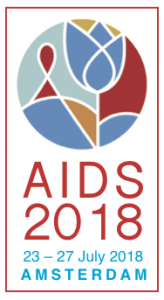Dolutegravir twice daily is effective and tolerable with rifampicin: 48 week results from the INSPIRING study
19 September 2018. Related: Conference reports, TB coinfection, World AIDS 22 Amsterdam 2018.
 Polly Clayden, HIV i-Base
Polly Clayden, HIV i-Base
Dolutegravir (DTG) 50 mg twice daily is safe and effective in HIV/TB co-infected adults receiving rifampicin-based TB treatment – according data presented at AIDS 2018. [1]
INSPIRING was a phase 3b, non-comparative, active control, randomised, open-label study in HIV positive ART-naive adults with drug-sensitive TB.
Preliminary week 24 data were presented earlier this year at CROI 2018. [2, 3]
Kelly Dooley from Johns Hopkins University School of Medicine presented the primary week 48 results on behalf of the INSPIRING investigators.
Participants receiving rifampicin-based TB treatment for at least eight weeks were randomised (3:2) to receive either DTG 50 mg twice daily during and two weeks post-TB treatment, followed by 50 mg once daily; or efavirenz (EFV) 600 mg once daily; both with two NRTIs (tenofovir DF with either FTC or 3TC) for 52 weeks.
The primary endpoint was the proportion of participants in the DTG arm with viral load <50 copies/mL using the modified FDA Snapshot algorithm in the ITT-E population. The study was not powered for non-inferiority.
INSPIRING enrolled 113 participants across 37 sites in low- and middle-income countries; 65 participants were from South Africa. Full enrollment took almost two years.
Participants were randomised to DTG (n=69) or EFV (n=44). Median age was 32.5 years, approximately 60% were men and 67% of African origin. Baseline CD4 was just above 200 cells/mm3 and viral load just above 5 log copies/mL. The majority had pulmonary TB and the median time from start of TB treatment was approximately 30 days.
The proportions of week 48 responders (ITT-E) were 52/69, 75% (95% CI: 65 to 86%) for DTG and 36/44, 82% (95% CI: 70 to 93%) for EFV.
Non-response in the DTG arm among 11 participants (16%) was mainly due to non-treatment-related discontinuations while suppressed (mostly lost to follow up).
Week 48 median CD4 increase in the DTG arm was 220 cells/mm3 and 190 cells/mm3 in the EFV arm. Two participants in the EFV arm discontinued due to AEs.
TB-associated IRIS rates were low (4 in each arm) but people with CD4 counts <50 cells/mm3at baseline were excluded from the study.
Median DTG trough concentration during twice-daily dosing with rifampicin was similar to that of once-daily DTG 50 mg without rifampicin. TB treatment success was high, approximately 90% in both arms.
comment
The DTG label already recommends twice-daily dosing with rifampicin, based on a previous drug-drug interaction study in HIV negative participants. [4] WHO also recommends this approach. [5]
A recent PK study looking at DTG 100 mg and 50 mg once daily in the presence or absence of rifampicin found that rifampicin reduced DTG C24h by 76% and 85% respectively compared with DTG 50 mg alone. [6]
In this study, the maximum induction of rifampicin was reached at three weeks and drug absorption reached saturation limit in the range of 50–100 mg DTG (rifampicin has no additional effect on the saturation limit of DTG absorption).
DTG C24h remained 2–14 fold above the in vitro protein adjusted IC90 of 64 ng/mL in all participants (but <300 ng/mL in the majority).
Whether DTG 100 mg once daily + rifampicin will be safe and effective in people with HIV/TB coinfection currently is unclear.
The study investigators (from Imperial College London, St Stephen’s Centre, Chelsea and Westminster Hospital and University of Cape Town) are planning follow up in patients. These evaluations will be highly monitored for safety.
References
- Dooley K et al. Safety and efficacy of dolutegravir-based ART in TB/HIV co-infected adults at week 48. AIDS 2018. Amsterdam. 23–27 July 2018. Oral abstract TUAB0206.
http://programme.aids2018.org/Abstract/Abstract/6122 (abstract)
https://www.youtube.com/watch?v=7XQjSgZKyyY (webcast) - Dooley K et al. Safety and efficacy of dolutegravir-based art in TB/HIV coinfected adults at week 24. 25th CROI. Boston. 4–7 March 2018.
Oral abstract 33.
http://www.croiconference.org/sessions/safety-and-efficacy-dolutegravir-based-art-tbhiv-coinfected-adults-week-24 (abstract)
http://www.croiwebcasts.org/console/player/37073 (webcast) - Clayden P. Twice-daily dolutegravir is effective and tolerable with rifampicin. HTB. 14 March 2018.
https://i-base.info/htb/33644 - Dooley K et al. Safety, tolerability, and pharmacokinetics of the HIV integrase inhibitor dolutegravir given twice daily with rifampin or once daily with rifabutin: results of a phase 1 study among healthy subjects. J Acquir Immune Defic Syndr. 2013 Jan 1;62(1):21-7.
https://journals.lww.com/jaids/Abstract/2013/01010/Safety,_Tolerability,_and_Pharmacokinetics_of_the.4.aspx - WHO. Updated recommendations on first-line and second-line antiretroviral regimens and post-exposure prophylaxis and recommendations on early infant diagnosis of HIV: interim guidance – policy brief. 23 July 2018.
http://apps.who.int/iris/bitstream/handle/10665/273632/WHO-CDS-HIV-18.18-eng.pdf - Wang X et al. Pharmacokinetics of dolutegravir 100 mg once-daily with rifampicin. 19th International Workshop on Clinical Pharmacology. Baltimore. 22–24 May 2018. Oral abstract 11.
http://regist2.virology-education.com/presentations/2018/Antiviralpk/22_boffito.pdf (PDF)

